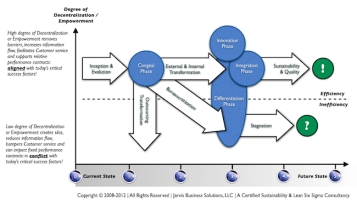“As we look ahead into the next century, leaders will be those who empower
others.” ~ Bill Gates
________________________________
Transformation is modeled with foundations for better leadership, based on these two lessons: The leanest will be more competitive [Lean Six Sigma – LSS]. The leanest will be better stewards and create a better chance of making the future a success [Sustainability]. All resources are finite, but the journey to pursue excellence is based on optimizing profitability. So, recognizing the definition of Sustainable Develop slightly refocuses our formula for increased Profitability:
Optimizing Profitability = Sustainable Development
+ Quality + Continuous Improvement + Secured Gains
Will transformation create opportunities for increased performance, reduced costs, provide for growth of brand and attract quality employees? Research and results indicate it will provide your organization with those opportunities and establish a Continuous Improvement process to refine and meet your future competitive landscape. Your true litmus test is two-fold. First, the results of aligning your Vision, holistically, to integrate Ethics into your organization and philosophy to create a unique Culture that attracts the quality people you want and need. Second, is the true increase in profitability and competitiveness that is an ongoing refinement by fusing Sustainability with an effective Quality effort.
This is an excerpt of my new book “Building a Bridge to Benefits”. Publication date is scheduled for November 2013 and is planned to be available on Amazon. More to come …
_____________________________________________________________________
Jarvis Business Solutions, LLC
Contact Information
Email: Ralph.Jarvis@JarvisBusinessSolutions.com
Blog: http://horizons.JarvisBusinessSolutions.com
Web site: http://www.JarvisBusinessSolutions.com
LinkedIn: http://www.linkedin.com/in/corporatesocialresponsibility/
Lead Smart, Endless Opportunities when Sustainability is driven by Lean Six Sigma
_____________________________________________________________________

